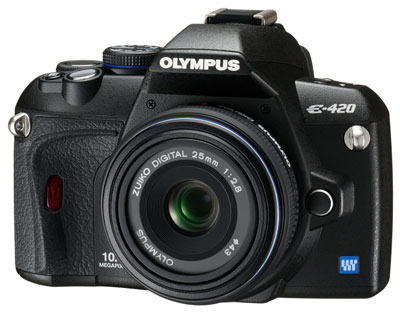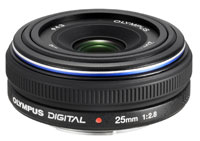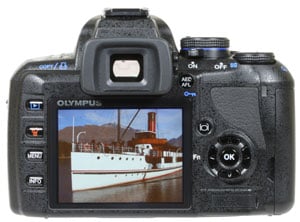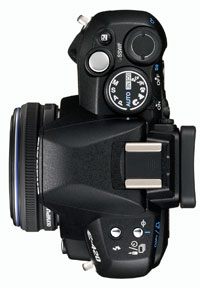Olympus E-420
-
-
Written by Gordon Laing
Olympus E-420 verdict
When Olympus launched the original E-400 to the European market in September 2006, it was a breath of fresh air. Inspired by classic 35mm film SLRs of the Eighties, the E-400 could boast the tag of World’s smallest and lightest DSLR, without compromising on comfort or handling. It may not have had much of a grip to speak of, but then neither did those older film cameras and no-one complained back then.
Its successor the E-410 brought Live View and Worldwide availability, and now we have the latest in the line, the E-420. Externally there’s some minor tweaks like a slightly bigger grip, slightly bigger screen, and blue labelling that’s more easily visible by those with colour blindness, but otherwise Olympus has sensibly stuck with a winning design.
 |
The most important physical change isn’t actually to do with the E-420’s body at all – it’s the simultaneous launch of the Zuiko Digital 25mm pancake lens. The previous 14-42mm kit lens may have been shrunk to better-match the physical characteristics of the earlier E-400, but it’s this new 25mm which really allows the form factor to make sense.
Fit the 25mm lens on the E-420 (or of course the E-410 or E-400), and you have yourself a seriously small DSLR. You only have to look at the front and especially the top views of the E-420 next to Canon’s EOS 450D / XSi on our design page to see how compact this combination is compared to an average DSLR kit. It’s really light too: the body, battery and lens add up to just 521g. The result may not be as small or light as a compact, but it’ll still squeeze into most coat pockets and is rarely a burden to carry around. Indeed if you were already considering a larger enthusiast compact like the Canon G9 or Sigma DP1, you should certainly also check out the E-420 with the 25mm.
 |
Of course a fixed focal length lens doesn’t have the flexibility of a zoom, but in its favour, the Zuiko Digital 25mm offers better quality than most kit zooms, is optically brighter at f2.8, smaller and lighter, while also being more usable than you’d first think. You only have to look at our E-420 Sample Images page to see we managed to capture our standard array of test shots by simply standing a little closer or further back. The 25mm may add $100 USD to the E-420 kit over the version with the 14-42mm zoom, but we’d say it’s the one to buy to really exploit its size.
So the lens is a no-brainer for Olympus owners who want the smallest and lightest working kit, but what about the new body? It may not be a huge departure externally, but Olympus has made a number of internal improvements to the E-420 which add up to a respectable package.
Headlining these enhancements is the new contrast-based autofocus option in Live View. Now you may be the kind of photographer who doesn’t care for Live View, but those who do, or who are upgrading from a point and shoot will appreciate the improvements on the E-420. The new Imager AF mode auto-focuses with a half-press of the shutter release quietly and without interrupting the image. It may be slightly slower than flipping the mirror down and back up again, but remains preferable for handheld work – and the traditional phase change AF is still available if you want it.
It’s also good to see Olympus extending the focus points to 11 in Imager AF mode, along with supporting face detection, which along with Shadow Adjustment Technology can ensure strongly backlit portraits will rarely need manual intervention.
The Imager AF mode currently only works with three Olympus lenses, but the new Hybrid mode works with any lens and uses the contrast technology to get the focus pretty close without interrupting the view, meaning the traditional AF sensor has little work to do once the picture is actually taken.
 |
All Live View modes on the E-420 also allow exposure compensation, white balance and depth of field previews, while additionally offering 100% coverage, a choice of alignment grids, a live histogram and useful magnified manual focus capabilities. It’s a decent implementation.
Olympus could have stopped there, but the E-420 also features a number of advanced options from the flagship E-3. So you get wireless flash control and a vast array of customisation. And while company’s like Sony are taking them out of its latest Alphas, the E-420 still offers mirror-lockup and optical depth of field previews.
The resolution may be the same as the E-410, but an improved sensor allows a greater dynamic range and delivers good quality images across its sensitivity. The sensor may be physically smaller than APS-C chips used by most DSLRs, but there’s little or no compromise at the 10 Megapixel resolution. There’s also the opportunity to hang onto more fine detail at higher sensitivities if you reduce the Noise Filter from its default Standard setting.
The E-420 also inherits the SSWF anti-dust system which remained the most effective of any we’ve tested. Despite our standard torture-test, our E-420 suffered from no visible dust marks which is a lot more than can be said for the competition.
Finally, the increased continuous shooting speed of 3.5fps is a welcome upgrade, especially as the camera can actually deliver it in practice.
As for downsides, the new 11-point AF system may be able to better lock onto subjects around the frame, but since the Imager AF mode is relatively slow in operation and continuous AF is not possible in the E-420’s Live View, it’s not going to help those who shoot action. Instead it’ll be back to the small optical viewfinder and basic 3-point AF system of its predecessor (and all Four Thirds DSLRs apart from the flagship E-3).
That said, unless you regularly switch between other DSLRs, you do get used to the E-420’s small viewfinder and it’s important to note the Sony A300 and A350 are no better in this regard. As for the AF system, 3-points may not be great for tracking off-centre subjects, but it’s fine for general use and certainly not put off an army of E-510 owners or those who went for the Nikon D40, D40x or D60.
The biggest issue facing the E-420 is, like its predecessor, a lack of anti-shake options. There’s none built-in, and very few lenses for the Four Thirds mount which offer an optically stabilised solution. Of course it’s important to remember we all lived without anti-shake not so long ago, and by using the 25mm f2.8 lens, you’ll have almost a full stop advantage over most kit zooms at wide angle or two stops when zoomed-in. Certainly, the extra light gathering power of this lens meant camera shake was never an issue for us while testing the E-420.
So before wrapping-up, how does the E-420 compare to its rivals?
Compared to Canon EOS 450D / Rebel XSi
 |
Price-wise, the older Canon EOS 400D / XTi is a closer match to the E-420, but with sales of the new Canon rocketing and rumours its predecessor may soon be discontinued, the newer 450D / XSi is the model we’ll be comparing it against here. At the time of writing, the Canon 450D / XSi kit came in at around 50% more than the E-420 with the 14-42mm, or around 25% more than the E-420 with the 25mm. Both cameras have a few aspects in common including 3.5fps continuous shooting and contrast-based AF in Live View, along with mirror lockup and depth of field previews.
In its favour the Canon 450D / XSi boasts two extra Megapixels, a stabilised kit lens, a slightly bigger 3in screen, a 9-point AF system, much bigger optical viewfinder, 14-bit image processing and RAW files, along with being supplied with PC / Mac software to remote control the camera including Live View on your monitor. The E-420 is of course cheaper, smaller and lighter, while boasting superior anti-dust capabilities.
The Canon 450D / XSi is a better-featured camera, but if you won’t exploit its benefits, it boils down to comparing physical size, comfort, price and dust reduction, all of which are in the E-420’s favour. See our Canon EOS 450D / Rebel XSi review for more details.
Compared to Sony Alpha DSLR-A300
 |
Sony’s middle model in its latest Alpha range is priced roughly the same as the E-420 with the 25mm lens or about $100 more than the E-420 with the 14-42mm. Both cameras share 10 Megapixel resolution and small optical viewfinders, but there the similarities end.
The first key selling point for the A300 is built-in stabilisation. Secondly is a screen which vertically tilts, allowing easier composition at high or low angles. The A300 also takes a completely different approach to Live View with its secondary sensor allowing the camera to use the same quick AF system as you would normally with the optical viewfinder – and it’s a more sophisticated 9-point system.
So far so good, but the A300’s Live View is not as accurate as either the E-420 or the Canon 450D / XSi. The E-420 also boasts quicker continuous shooting, more effective dust reduction, greater customisation, mirror lockup and depth of field previews, while of course being smaller, lighter, and in its 14-42mm kit, cheaper. The built-in anti-shake and flip-out screen on the A300 though remain very tempting. See our Sony Alpha DSLR-A300 review for more details.
Compared to Olympus E-510
 |
Here’s an interesting one. With the E-520 just around the corner, the E-510 finds itself increasingly discounted and at the time of writing you could buy the E-510 in a twin lens kit for around the same price or even less than the E-420 with the 25mm pancake. The E-510 of course boasts built-in stabilisation and you’re also getting two lenses for the same money. You’d be mad to buy the E-420, right?
Well the E-420 is of course smaller and lighter, and the pancake lens does add to the cost of the kit. The E-420 also has a number of features absent from the older E-510, including contrast-based AF in Live View, slightly quicker continuous shooting, 11-point AF and face detection in Live View, wireless flash support, greater customisation and a slightly bigger screen. That said, the anti-shake capabilities and cheap lens bundle is hard to pass up – in fact with the current discounts the E-510 is just amazing value. See our Olympus E-510 review for more details.
Compared to Olympus E-520
 |
Finally we have to mention the forthcoming Olympus E-520. No-one’s tested it yet, but in terms of features it could end up being the E-420’s biggest rival – and indeed serious competition for the established players too. The E-520 essentially takes everything you have with the E-420, but fits it into a slightly larger body that boasts built-in anti-shake capabilities. Interestingly, Olympus no longer offers an underwater housing for the E-420, and it’s the new E-520 which has this option.
But like the E-410 and E-510 before them, the choice really boils down to whether you prefer to have the anti-shake or the smallest and lightest DSLR around. Like those older models, most will vote for the stabilised model, but we’d urge anyone who’s in the market for a smaller DSLR to try out the E-420 for themselves as its physical characteristics can easily win you over. See our Olympus E-520 preview for more details.
Also consider
If you’re after a budget DSLR, you should also compare the Olympus E-420 to the Nikon D40, Nikon D60, Pentax K200D and Canon’s EOS 400D / XTi.
Final verdict
Olympus has certainly made a number of improvements to extend the appeal of the E-420. The contrast-based AF, varied previews, wireless flash capabilities and broad degree of customisation to name a few are all welcome improvements. And despite concerns over the size of the Four Thirds sensor in relation to other DSLRs, the E-420 holds it together as well as the best 10 Megapixel models.
 |
But the E-420’s real appeal is its size and weight, especially when coupled with the new 25mm pancake lens. The earlier 14-42mm kit zoom was already pretty compact, but fit the E-420 with the 25mm and you have a seriously small DSLR kit. Small enough to appeal to those upgrading from a point and shoot, light enough to take on any hike or day out, and quite able to squeeze into smaller bags or larger coat pockets.
Indeed while being perfectly suitable as a primary DSLR, the E-420 and pancake lens will equally appeal to those with larger DSLRs looking for a secondary, smaller option – even if they use a different brand. These people may have been considering enthusiasts compacts like the Canon G9 or Sigma DP1, but by going only a little larger they could enjoy a fully-fledged DSLR with the power and flexibility that brings.
Once again though most of the downsides are the same as its predecessor: the viewfinder is narrower than most rival DSLRs and the basic 3-point AF is not best-suited to moving subjects. The biggest problem also remains the lack of viable anti-shake options, but you have to ask yourself if you really need it, especially if you’re using a 25mm f2.8 lens.
Ultimately if stabilisation isn’t a priority, the E-420 is a great choice. The body is extremely portable without compromising handling or comfort, the control system quick and easy to use, the SSWF filter remains the best around, the degree of customisation impressive, and the Live View facilities have further matured. There may not be enough to tempt existing E-410 owners to upgrade, but we can Highly Recommend the E-420 to any new buyers who want a small and light DSLR – you’ll simply take it almost everywhere with you.
So with the E-420 and pancake lens, Olympus has created a DSLR kit which will appeal to a broad group of buyers: those upgrading from a point and shoot, those who leave a DSLR at home because it’s too big or heavy, and those who want a smaller, lighter backup body to a higher-end model. We were already very fond of its predecessor, so with the new enhancements and the introduction of the 25mm pancake, the E-420 has become better still.
But the fact is, the E-520 is just round the corner and like the E-510 before it, most buyers will inevitably go for that over the E-420. While built-in stabilisation is undoubtedly tempting though, it’s a shame if you automatically rule-out the E-420 for not having it. To do so would be missing out on one of the most unique DSLRs around right now, so ask yourself very carefully – do you really, honestly need stabilisation?
|
Bad points | Scores (compared to 2008 budget DSLRs) |
 | ||
Build quality: Image quality: Handling: Specification: Value:
Overall: |
18 / 20 17 / 20 18 / 20 15 / 20 17 / 20
85% | |||
| ||||




